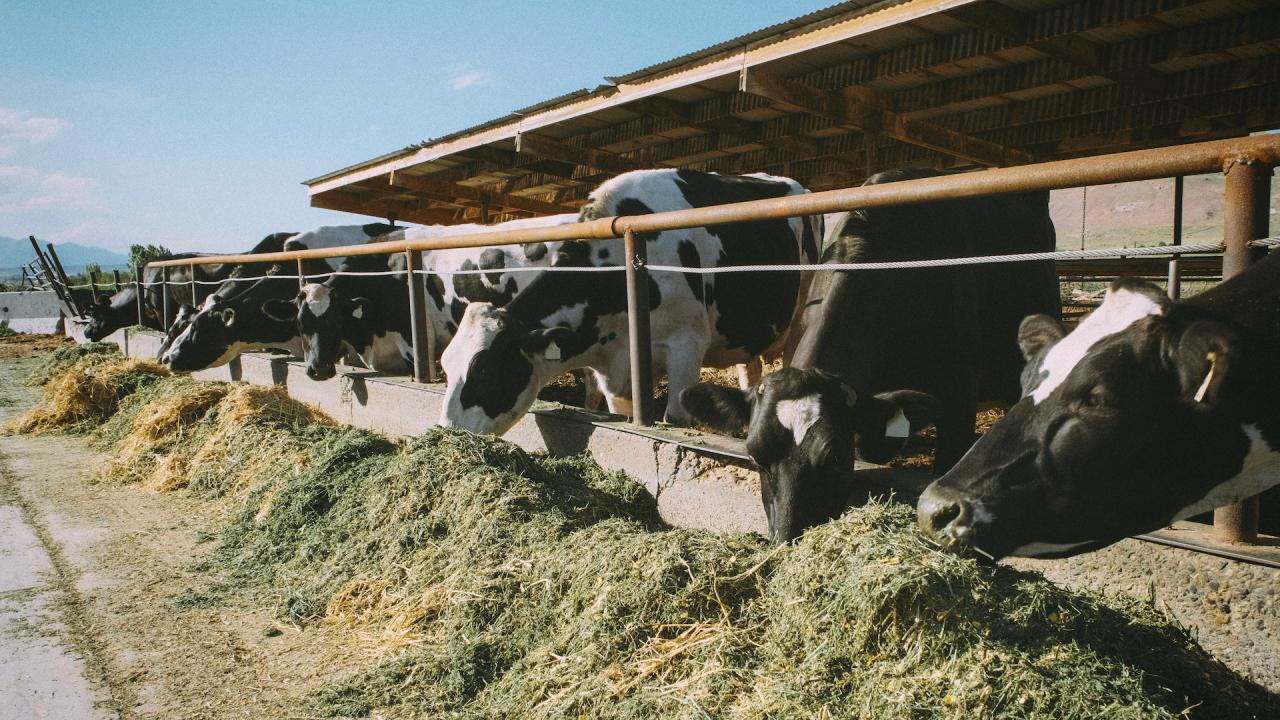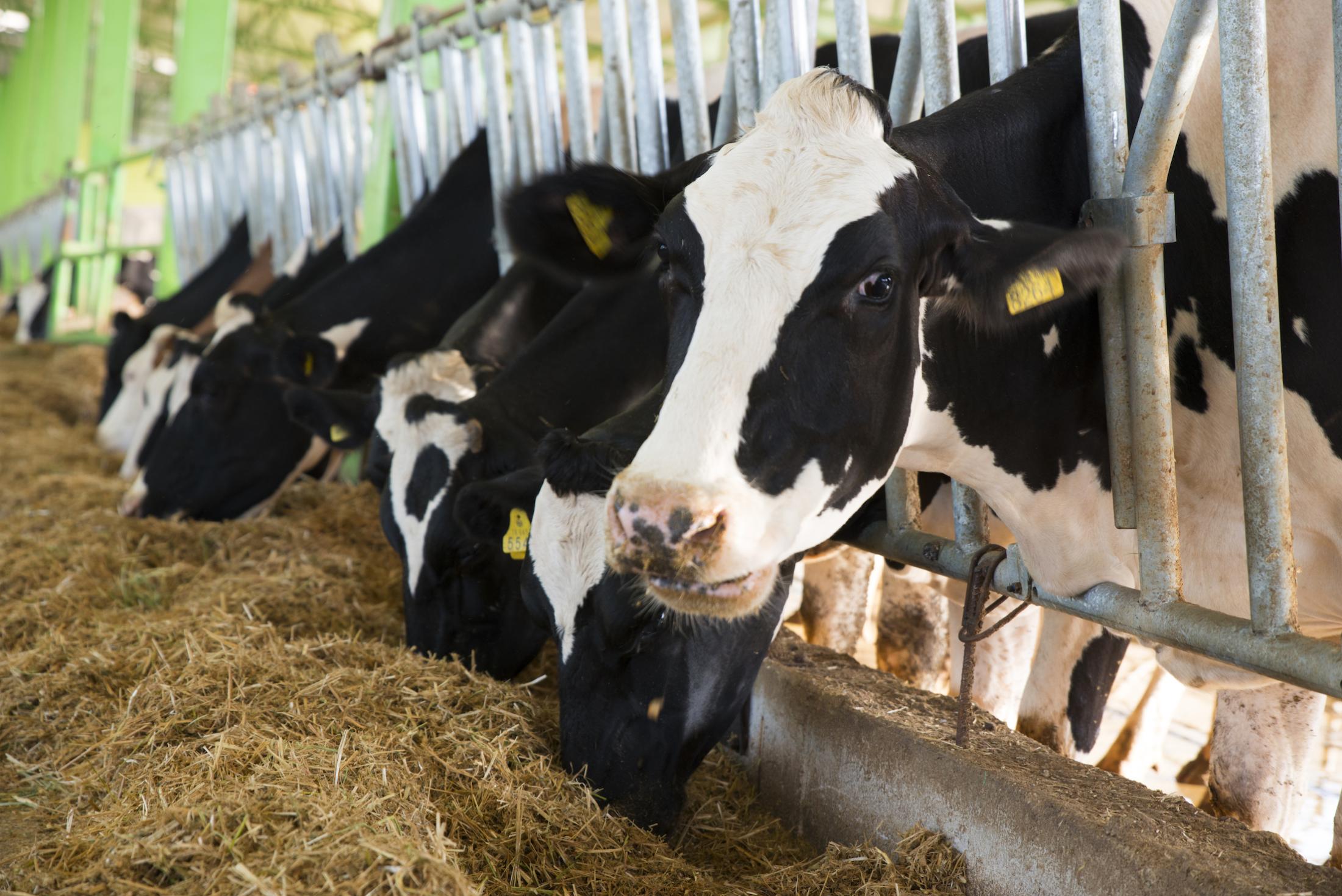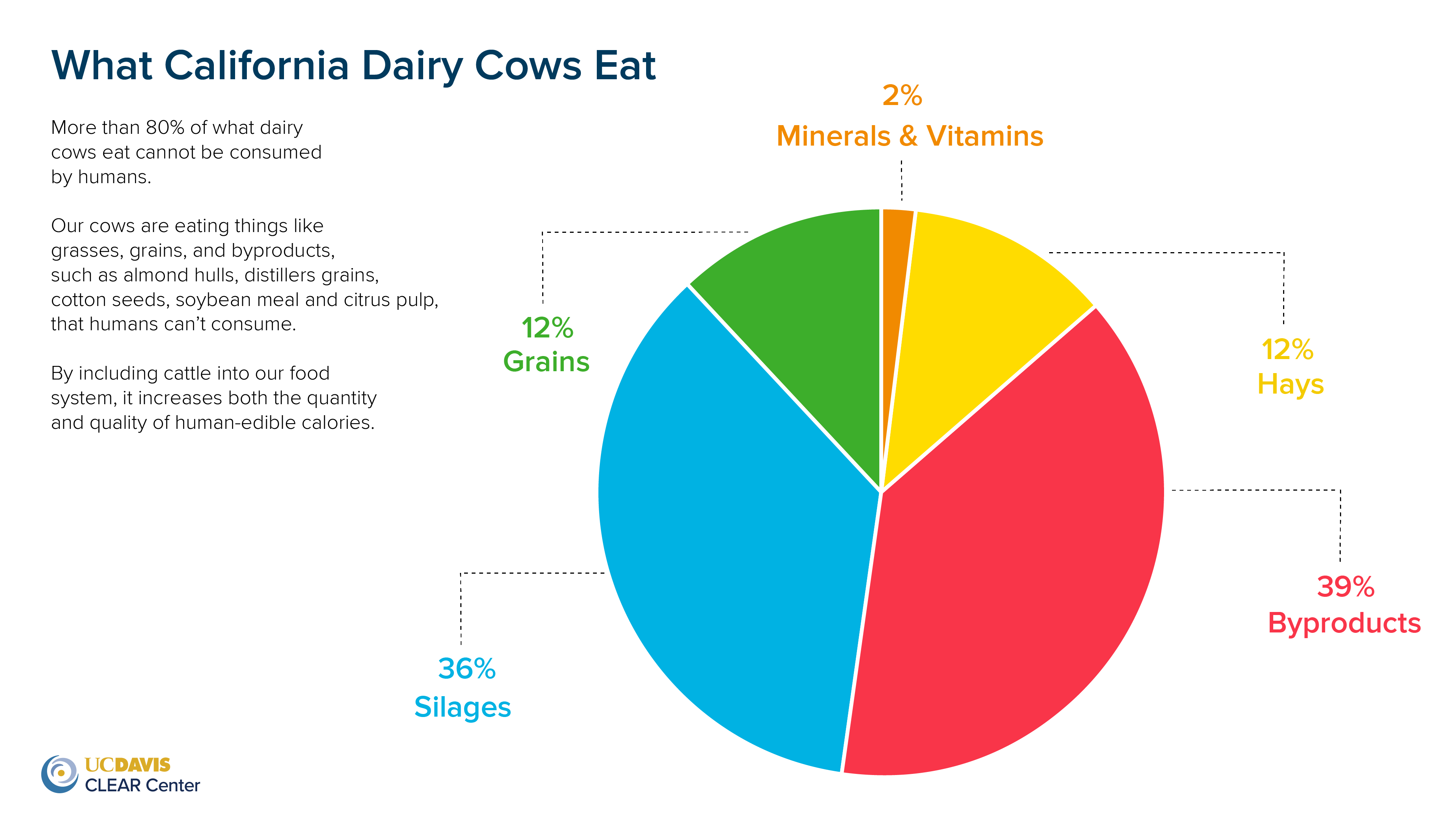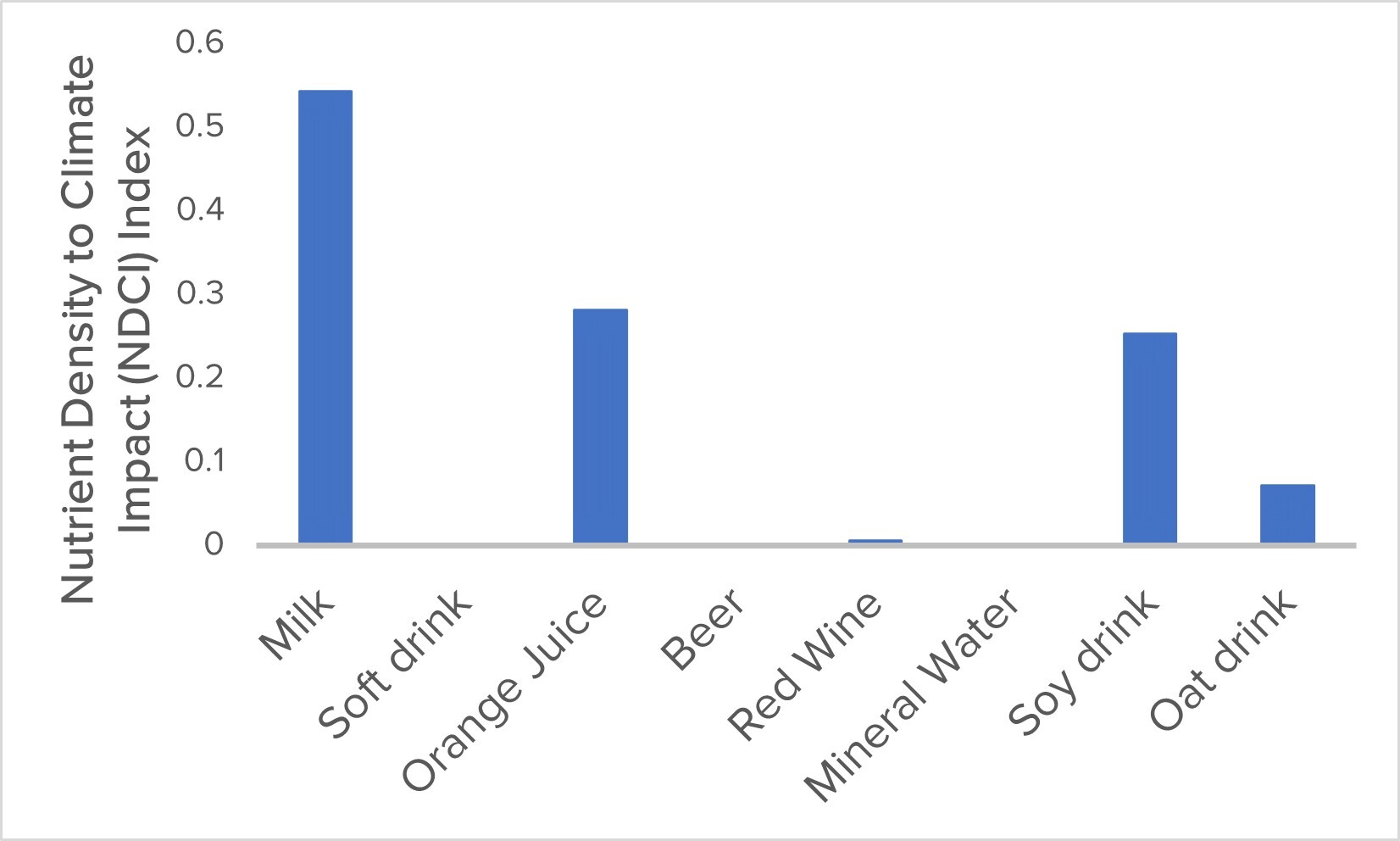
Dairy Cows — The Original Upcyclers
How ruminant digestion turns byproducts into high-quality nutrition
Given the millions of tons of feed that feed our dairy cows, the question may arise: Why we don’t use that food to feed people instead? This is a reasonable question, with a simple answer. More than 80% of what dairy cows eat cannot be consumed by humans. Our cows are eating things like grasses, grains, and byproducts such as almond hulls and citrus pulp, that humans can’t consume. By including cattle into our food system, it increases both the quantity and quality of human-edible calories.
The Ruminant Stomach
Dairy cows belong to a group of animals known as ruminants, which include mammals such as cattle, sheep, and deer. These animals are historically prey animals, meaning they predominantly consume plants and are hunted by various predators. By evolving as a ruminant, dairy cows can consume a large meal in a short period of time. Once their stomachs are full, they seek shelter to rechew their food into smaller and smaller pieces for further digestion as well as avoiding potential predator threats. This repetitive grinding motion looks almost as if they’re chewing gum. On average, dairy cows spend at least 8 hours and in some cases up to 14 hours every day lying down and ruminating.
As an adaptation to the types of feed they consume, all ruminants have evolved in tandem with a ruminant stomach. Starting with the esophagus and ending with the intestine, the ruminant stomach is composed of four compartments including the rumen, reticulum, omasum, and abomasum (Figure 1). Along with chewing, the rumen and reticulum break down feed into smaller and smaller particles via microorganism digestion. In between the omasum plays a large role in water reabsorption. Lastly, the abomasum breaks down feed via enzyme digestion and is similar to a human stomach. This unique adaptation allows our dairy cows to consume diets that are high in fiber, grasses, and feedstuff byproducts that humans cannot consume.

What Do Cows Eat?
On most dairy farms, dairy cows eat what’s called a total mixed ration (TMR; Figure 2) that is made up of corn silage, grass silage, and byproducts from the human food supply chain such as almond hulls, cottonseeds, and soybean meal. From this big picture overview, let’s take a further look at each ingredient in a dairy cow diet.

Forages
Forages include items such as grasses, legumes, and shrubs, and are the largest contributor to dairy cattle diets. We observe that almost half the diet in the California production system is made up by two types of forages: silages (36%) and hays (12%; Figure 3). Silages are fermented grasses and legumes that are stored over months which improves the nutrition for cows. As the size of dairy farms has increased, it has become difficult to have enough land to grow fresh forage for cows to eat every day. Not to mention, some of the largest dairy producing states (Wisconsin, New York, and Idaho) experience harsh winter climates, not suitable for growing crops. Therefore, to have high quality feed available year-round, many farms have opted to store their forages as silages and hays. Common silages fed to dairy cows include ryegrass, alfalfa, and corn silages, and the common hays are alfalfa and Timothy.

Credit: CLEAR Center
Forages provide both fiber and energy or protein depending on the forage being fed. Legumes such as alfalfa will have a greater amount of protein and grasses such as ryegrass or corn will be higher in energy. Fiber is an essential part of the diet by stimulating the process of rumination and keeps the stomach functioning healthy and well. Most dairy cows will eat almost one percent of their bodyweight in forage (~15 lbs) every single day.
Byproducts
The next largest contribution to the dairy cattle diet comes from byproducts, which are leftovers from crops grown for people. Several of the main byproducts fed to cows include distillers grains, almond hulls, soybean meal, and citrus pulp. In California, almost 40 percent of a dairy cow’s diet is made up of byproducts (Figure 3). That means, if you factor in the forage and byproducts cattle eat, over 85% of what they consume is made up of feeds that humans can’t consume.
If these byproducts were not consumed by cows, they would likely head to the landfill, as there is no other industry that has a use for them. Trucking these byproducts to the landfill carries its own environmental impact as well. At the garbage dump, these byproducts decompose under anaerobic conditions leading to the production of methane. Multiply this across the entire food system and the millions of pounds of byproducts that could be decomposing have huge climate implications. The carbon emissions of sending byproducts to a landfill for incineration are on average 60% greater than feeding them to cows. Not to mention, cows provide a nutrient-rich edible food in the form of milk and meat. This process by which we turn low quality feed ingredients in the form of byproducts and forage into a higher quality, nutritious product is known as upcycling.

Photos by Joe Proudman / CLEAR Center.
Grains
The third largest portion of the diet comes from products such as dried ground corn and barley, which serve as an excellent source of energy. On a national level 20% of the diet is made up of grains. Whereas in California, grains are a smaller contribution at 12% of the diet (Figure 3). This is the only category of dairy cattle feed where livestock compete with human edible feed. However, most of the corn grown in the United States is intended for animals and is not as sweet or tasty as the sweet corn you may consume during the summer months. Only a small portion of a cow’s diet is in competition with human food and is a necessary part of the diet to sustain high levels of milk production.
Minerals and Vitamins
Finally, the last portion of the diet and the most minute comes from minerals and vitamins (2%; Figure 3). These are generally fed to cows through a premix prescribed by a trained nutritionist, who creates recipes to meet the dietary requirements of cows. Although it may be the smallest component, this doesn’t mean it’s not important as all animals just like humans need their daily consumption of appropriate vitamins and minerals to perform their best.
The Nutritive Value of Food
This may beg the question: If we’re feeding these grasses, grains, and byproducts to cows, why can’t we consume the plants instead and bypass the cows? When making decisions about what we eat and drink, we may consider the environmental impact of the food, as well as the number of nutrients in it. If we compare a variety of beverages solely by looking at their raw emissions in CO2 equivalents (CO2e) per 100 grams of drink, we see that the highest greenhouse gas emission drinks are associated with red wine, followed by soft drinks and then milk (Figure 4a). If we are only concerned about consuming beverages that have low greenhouse gas emissions, then this figure suggests we should only be consuming mineral water, soy drink, or oat drink.

However, this would be a short-sighted since humans —just like cows— need their daily requirements of protein, carbohydrates, fats, minerals, and vitamins. Nutrition is not just about consuming calories but the number and variety of nutrients we consume. The nutrient density of food metric does just that by looking at the total nutrition package offered by each food. Foods with a greater diversity and quantity of essential nutrients will have a higher nutrient density score. These nutrients can be naturally abundant or added to improve the nutrition profile of the food. However, many plant-based drinks have vitamins and minerals artificially added because they are not naturally abundant compared to dairy milk. With the inclusion of nutrient density measurements in the analysis, using the Nordic dietary guidelines, a different story appears. By dividing nutrient density by the greenhouse gas emissions per 100 grams of beverage creates the Nutrient Density to Climate Impact (NDCI) index (Figure 4B). In other words, what is the quantity and quality of nutrients we consume while accounting for the greenhouse gas emissions associated with producing that food. Those foods with a greater ratio have a greater nutrient package given the environmental impact of producing those foods. After implementating this ratio, milk sorts itself to the top among the listed beverages followed in second by orange juice and then soy drink.

This is by no means intended to suggest that one type of milk or plant-based drink is definitively better than the other. People have varying circumstances that lead them to choose beverages that best suit their lifestyle, health, and tastebuds. Nutrition and environmental impact are simply factors in our food choices.
Nourishing Our Bodies
In conversations about diets and food choices, decisions must be made respective not only on the greenhouse gas emissions per unit of food or calorie produced but also the nutrients present in this food. A dairy cow consumes approximately 110-120 pounds of food per day that is in the form of low-quality human food, much of it being from industries that have no other use for the feed. This is then converted into approximately 70-80 pounds of milk that are nutrient dense and include many components of a healthy diet. Without cows, a diet of only almonds and oranges would leave our bodies undernourished and our landfills overfull. By incorporating cows into our food system, we increase the amount and the quality of human consumable food.
